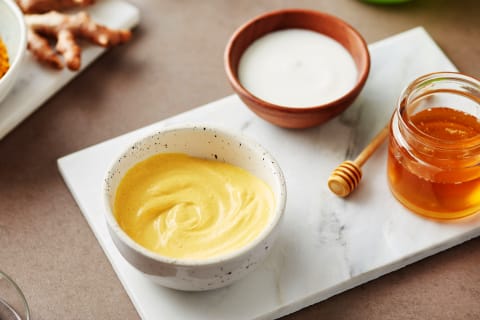“When I get that scratch in my throat, I go straight for the Manuka honey,” Will Cole, D.C., IFMCP, functional medicine expert, told mbg. “This honey from New Zealand has even higher nutritional content than regular raw honey and has next-level antimicrobial properties. I’ll add a little to my dandelion tea throughout the day.” But what sets it apart from all the other wonderful honeys out there? While raw honey’s reputation as a medicinal aid is largely due to its antimicrobial activity that stems from its hydrogen peroxide3 content, Manuka honey contains additional compounds—methylglyoxal (MGO), dihydroxyacetone (DHA), and a few others—that make it even more beneficial4 for both internal and topical use. These special compounds originate from—you guessed it—the nectar of the Manuka flower. Try it: For a simple face mask, spread a tablespoon of Manuka honey over your clean face (avoiding the eyes). Leave it on for 20 minutes, then rinse with warm water. Pat your face dry and apply your favorite moisturizer or facial oil. For additional skin-brightening, acne-fighting benefits, mix the Manuka honey with a pinch of turmeric before applying. Try it: Add a teaspoon of Manuka honey to your evening cup of chamomile tea or golden milk. Try it: For small, manageable cuts and scrapes, add a dab of Manuka honey directly to the skin before attaching your bandage. For larger wounds, always consult a doctor. Try it: Simply swallow a tablespoon of Manuka honey straight-up and allow it to coat your throat. Alternatively (or additionally), you can add Manuka honey to ginger tea for extra anti-inflammatory benefits. Additionally, Manuka honey contains a certain type of sugar called oligosaccharides7, which has a prebiotic effect17 and may help promote the proliferation of good bacteria. Try it: Incorporate Manuka honey into your daily diet in a variety of ways, like making it your go-to natural sweetener for teas or adding a drizzle to your morning yogurt. Just keep in mind, it still contains sugar, so you shouldn’t go overboard. People with diabetes may also want to consult with a doctor before adding Manuka honey to their diet since all honeys contain sugar and may negatively affect blood glucose if levels aren’t carefully monitored. But as amazing as Manuka honey can be, not all Manuka honey is created equally—the potency of Manuka can vary drastically even within the same brand, and some companies have even attempted to sell counterfeit Manuka products. When you shop for Manuka honey, you’ll want to make sure it’s been deemed authentic by a reputable grading system. The most common grading system, which some consider the gold-standard, is the Unique Manuka Honey Factor (UMF). It was developed by the UMF Honey Association in New Zealand, and it grades Manuka honey based on its levels of MGO, DHA, non-peroxide activity (NPA), and leptosperin. Every jar of Manuka honey is given a rating from UMF 5+ to UMF 20+. Opt for honey with a UMF rating of at least 10+ to ensure it has sufficient potency to deliver real benefits. The MGO grading system, which was developed by a New Zealand professor, measures only levels of MGO. Seek out Manuka honey with an MGO rating of 250 or higher, which is an approximately equivalent to UMF 10+. The K-Factor rating system is used only by the brand Wedderspoon, but it’s been given the OK by the New Zealand government. It measures markers such as purity, live enzymes, DHA, pollen count, pH levels, antioxidant levels, and phenolic compounds. Wedderspoon offers honeys with a K-Factor of 12 or 16, with K-Factor 16 containing more beneficial compounds. Additionally, all Manuka honey is (by definition) raw and unpasteurized to preserve its beneficial live enzymes and other compounds. If you purchase Manuka honey featuring any of the above ratings, you can be sure it is raw and unpasteurized.



